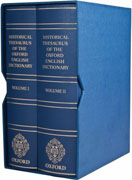
Historical thesaurus of the Oxford english dictionary: with additional material from a thesaurus of old english
Kay, Christian
Roberts, Jane
Samuels, Michael
Wotherspoon, Irene
The largest thesaurus in the world and the first historical thesaurus for anyof the world's languages. A complete sense inventory for English from Old English to the present day, based on the Oxford English Dictionary. Thematic system of classification provides a unique view into the development of words withsimilar meaning over time. Chronological ordering of synonyms, showing dates of first recorded use in English, with earliest synonyms first. Handsome package includes two volumes in sewn cloth binding in a slipcase, with four-colour fo.old-out chart illustrating the thematic structure of the thesaurus. 800,000words and meanings and 235,000 entry categories (Volume 1) plus comprehensiveIndex (Volume 2) for cross reference and alphabetical lookup. The Historical Thesaurus of the Oxford English Dictionary (HTOED) is a unique new resource charting the semantic development of the huge and varied vocabulary of English. It is the first comprehensive historical thesaurus ever produced for any language, containing almost every word in English from Old English to the present day, and is a magnificent resource for the historical study of the language. Itis based on a detailed analysis of English as found in the second edition of the Oxford English Dictionary (OED) and also draws on A Thesaurus of Old English. Conceived and compiled by the English Language Department of the University of Glasgow over a period of some 45 years, the Historical Thesaurus of the Oxford English Dictionary is a groundbreaking analysis of meaning in the history of English. The thesaurus organization follows a unique thematic system of classification, with entries arranged in a comprehensive semantic hierarchy according to their meanings. Each individual synonym is presented in chronological order according to the first recorded date of the word's use in English as listed in the Oxford English Dictionary, with earliest synonyms given first. There are three major sections in the HTOED, reflecting the main activities and preoccupations of users of the language: I The external world. II The mental world. III The social world. These in turn are divided into 354 major categories, such as Food and drink, Thought, or War. Further categories and subcategories follow, moving from the most general ideas to the most specific. Overall, the HTOED contains around 800,000 meanings, organized into more than 236,000 categories and subcategories. The semantic categories and subcategories are headed by phrases which define them and link to preceding sections. In the abridged example given here, the headings and numbering show that Terms of endearment, at the fourth level ofthe semantic hierarchy, are part of Love, which is classified within the higher category of Emotion, which in turn comes under The mind. 02 The mind....02.02. Emotion....02.02.22. Love....02.02.22.04. Terms of endearment.... The HTOED contains obsolete, historical, and archaic vocabulary, as well as the vocabulary of current English; it covers scientific, technical, and specialist terminology as well as slang, dialect, and informal language, and regional varieties of English from all parts of the world. Each term is precisely entered into its place in this comprehensive hierarchy of meaning, according to its meaningand date, and is accessible either by browsing at any level of the hierarchy,or by looking up a particular word in its alphabetical place via the Index. The Index itself lists nearly one million references and ensures a comprehensive lookup and accessibility of the full text. The final printed work is presented in two volumes: Volume 1 is the Thesaurus, while Volume 2 is the alphabetical Index listing the synonyms in Volume 1. Readers may thus approach the content of the Thesaurus in different ways: either by looking up a single lexical item in the Index and being directed to the appropriate section in the main Thesaurus, or by browsing by semantic category directly, and seeing words in their context of both historical development and the overall organization of meaning. There is an Introductory essay by theEditors and a Foreword written by Lord Randolph Quirk, together with a specially commissioned fold-out chart showing the principal levels of the semantic classification.
- ISBN: 978-0-19-920899-9
- Editorial: Oxford University
- Encuadernacion: Cartoné
- Páginas: 3952
- Fecha Publicación: 01/10/2009
- Nº Volúmenes: 2
- Idioma: Inglés
